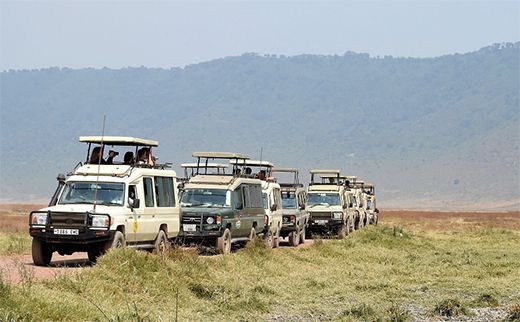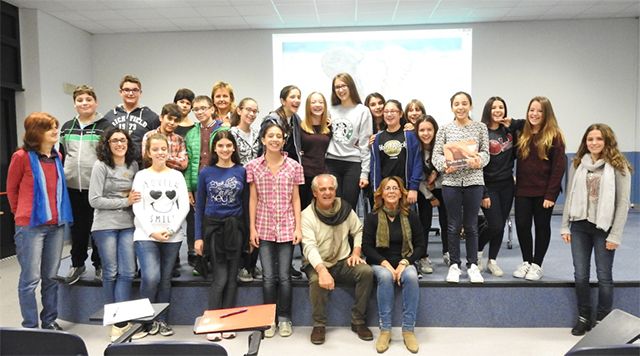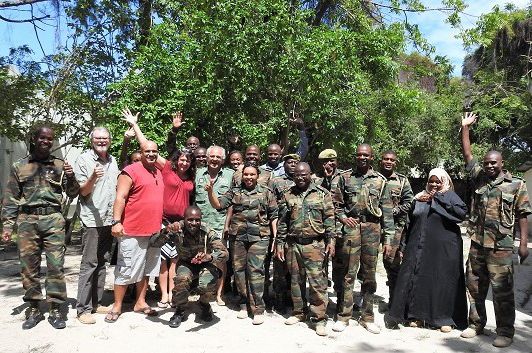
10-09-2017 by Adriano Ghirardello

There's always a desire in me to deal with wild reality across the border, if only to learn how others are organized and how much could be improved in the reality of parks in Kenya, especially in Tsavo East.
We could call it "an out-of-door trip" for the Friends of Tsavo: two thousand km between return, with our car, through Tanzania to the Cratere di Ngorongoro, visited after ten years, when still my curiosity was only as a tourist and not as Honorary Warden of KWS.
Customs formalities to begin with: yellow fever, Visa, and deposit of the booklet owned by the car, you take out insurance that authorizes you to travel in the country for a month, I am then favourably impressed by the cleanliness of the streets and villages, a little less from the numerous bumps and checks of the local police that every 5/6 km you stop just to greet you, seen a Kenyan plaque, (the only one in the three days of stay in Enchanting landscapes comparable to those of our Kenya but excellent organization regarding entry and stay in the NogorongoroConservancy and its descent to the crater.
The sign at the entrance, BiosphereReserve - World Heritage Site, but above all intriguing respect for the place to visit.
No less interesting is the cost for entry tickets: only the car, weighing up to 3000 kg, pays about 40,000 kenyani schillings, the descent to the crater requires an extra 40,000 ksh for a single day while tourists pay about 90 dollars for 24 hours. An important figure that leaves you almost breathless there, but then you understand that this money is used at its best in exchange for basic services that in Kenya we generally don't have. Surprisingly, the ranger at the entrance of the crater, which forces you to get off the car to read a long line of rules to be respected, reported on a billboard more than two meters high. Maximum speed 25 km/h, only professional guides certified and with 4X4 cars are allowed, off-piste driving is prohibited, animals must be kept at least 25 metres away from the animals, the ground and vegetation must be respected, various garbage must not be thrown away on the ground, fires must not be ignited and so on. While I diligently read the various rules with the ranger to which I'm HonoraryWarden of KWS in Kenya doesn't care, I smile and think back to the Tsavo East that in terms of rules is an undisciplined Wild West and how much it costs me to reproach the drivers to remind them to comply with the rules that there are but very few respect, despite have been distributed also stickers to stick inside the cars where
After a strict control of the entrance tickets where, all with regular receipts, are reported how much paid and the time of entry, we descend into the crater surrounded by a luxuriant vegetation that makes envy thinking about the drought of Tsavo, convinced that, at times Mother Nature, is ungrateful and distributes its resources in an unfair way. And here are the first animals to manifest themselves: a group of Land Cruisers perfectly aligned on the road admires a family of lions who are pastaing with a poor gnu. Silence, noiseless engines only hear the clicks of the cameras. The lions look indifferent and shortly after the drivers start at 25km/h in search of other scenes to photograph, calmly without tinkering with each other.
There is no doubt that animals are in an earthly paradise: the season is dry there too, but there are small lakes with spring and fresh water, plains for the numerous herbivores, an exaggerated quantity of hyenas and jackals that have food at will and that are also close to the lions they are eating, without the hysterical and fake awe-inspiring ones that they sometimes put into practice. The stop-off points are well indicated: tourists can get off from their cars, eat a breakfast or lunch-box in tranquility and take advantage of toilets constantly kept clean by the staff present from six in the morning until six in the evening, the opening hours of the park. Small services that make a difference. The rangers of Ngorongoro patrol the crater being careful that the rules are respected. In front of another large family of lions, about twenty Land Cruisers line up. One by one, after a reasonable time to give you the chance to take pictures, they move away, leaving room for the driver behind them and so on until the last of the row.
It will be a paradise for animals but drivers so disciplined are a paradise also for the rangers assigned to control.
We find a lion on the roadside, visibly asleep after a lute meal, and I wonder if I have to encourage him to move away in order to respect the 25 meters of distance between us and him, always respecting the general rules of the park.
The last surprise I find the road in reserve for me to climb up from the crater: the entire ascent route has been paved with solid auto-blockers, a luxury to be in a park and I am thinking of the rainy season where, without this flooring, the cars would not be able to climb and the park would remain closed and unfit. Ultimately, you are convinced that the high entry costs are justified and that good road maintenance has a high price to pay and Ngorongoro seems to work all the best.
The tourist season doesn't have stagnant periods and from all over the world, especially Americans and Japanese, come to see this wonder, filling all the lodges inside the conservancy and on the edge of the crater, paying for dollars because there one night don't give you. We return to Kenya with the hope of sharing our experience with those who can do something to improve the kenya parks, starting from the professionalism of the drivers who should be authorized and certified safari guides: it can really make a difference for the respect of animals and their habitat.
Too often I have heard me answered from drivers, certainly impervious as safari guides, that the park is their land where they can do what they want, including showy off-piste to go so close above all to the lions that they perceive their breath, without understanding that the disturbed animals get away inward to be so quiet, preventing other tourists (payers) to enjoy the same scenes, not to mention destruction
There is still a lot to do, but it is a moral obligation not to give up for lost the achievement of this goal, achievable with the collaboration of everyone, tourists including that often photographing with a tablet or mobile phone incite their drivers to get as close as possible to the animals if nothing else to be a selfie to post on Facebook.
Is a simple photo worth more than the respect for an animal of the savannah? I do not think so!
ITALY
by redazione

The Friends of Tsavo back in Italian schools to raise awareness among young people about the protection of the animals of the African reserves and to promote the good side of the Black Continent, the least publicized by the media...
OPINIONS
by redazione

'Getting out of the off-road vehicle and walking in the Tsavo is the last thing he should...
NEWS
by redazione

Progress for the tarmac of the road that leads to the entrance hall from Malindi Gate of Tsavo East National Park.
After the stretch from Malindi to the village of Ganda they have been leveled and are now in very good...
NEWS
by redazione

The sadness is deep for fans of the savannah that after so many safari, had learned to recognize it.
Satao II, one of the few remaining elephants by the giant tusks in Kenya, the "big tuskers" (estimated there would be no...

Even Malindi has celebrated the Rangers World Day and confirmed the spirit of collaboration between the Kenya Wildlife Service and the town's foreign community.
In the presence of Senior Warden Jane Gitau, KWS met at the Malindi Marine Park, and before...
WILDLIFE
by Leni Frau

He was one of Tsavo's "Super Tuskers." Lugard, an iconic elephant with huge tusks and regal bearing, also...